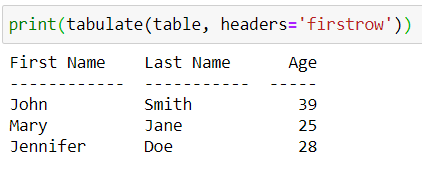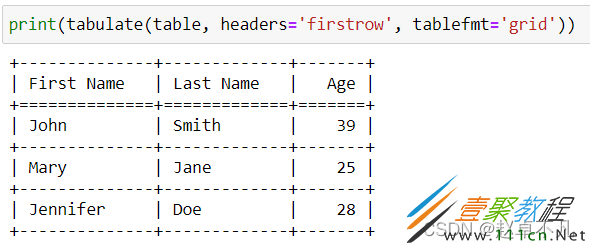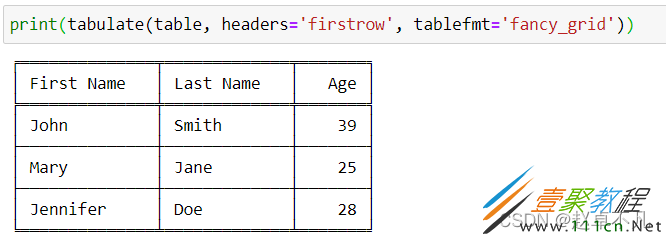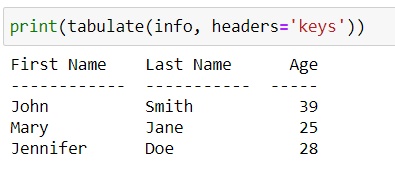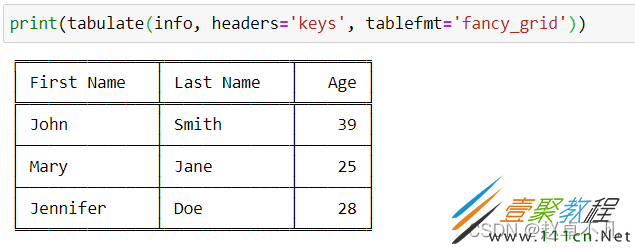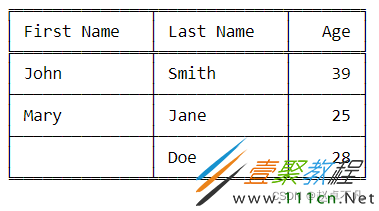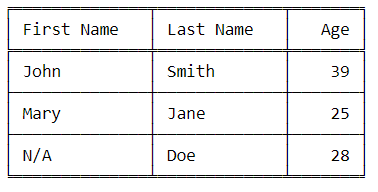Python中创建表格代码方法
本篇文章小编给大家分享一下Python中创建表格代码方法,文章代码介绍的很详细,小编觉得挺不错的,现在分享给大家供大家参考,有需要的小伙伴们可以来看看。
1. 引言
如果能够将我们的无序数据快速组织成更易读的格式,对于数据分析非常有帮助。 Python 提供了将某些表格数据类型轻松转换为格式良好的纯文本表格的能力,这就是 tabulate 库。
2. 准备工作
安装tabulate库安装tabulate库非常容易,使用pip即可安装,代码如下:
pip install tabulate
导入tabulate函数接着我们需要导入我们需要的tabulte函数,如下:
from tabulate import tabulate
准备工作做好后,接下来我们来举个栗子。
3. 举个栗子
3.1 使用list生成表格
接着我们假设我们有以下数据:
table = [['First Name', 'Last Name', 'Age'], ['John', 'Smith', 39], ['Mary', 'Jane', 25], ['Jennifer', 'Doe', 28]]
接着我们可以使用 tabulate 函数将上述数据组织成一个更易读的表格形式,代码如下:
print(tabulate(table))
结果如下:
由于上述list中的第一个列表包含每列的名称,我们可以使用以下参数将列名单独显示出来,代码如下:
print(tabulate(table, headers='firstrow'))
结果如下:
tabulate 函数还包提供一个 tablefmt 参数,它允许我们进一步改进表格的外观,代码如下:
print(tabulate(table, headers='firstrow', tablefmt='grid'))
结果如下:
相比grid,我更喜欢对 tablefmt 使用fancy_grid参数,其表现形式如下:
print(tabulate(table, headers='firstrow', tablefmt='fancy_grid'))
结果如下:
3.2 使用dict生成表格
当然,在Python中我们也可以使用字典来生成相应的表格。代码如下:
info = {'First Name': ['John', 'Mary', 'Jennifer'],
'Last Name': ['Smith', 'Jane', 'Doe'],
'Age': [39, 25, 28]}
在字典的情况下,键通常是列的标题,值将是这些列的元素取值。我们通常通过传递“keys”作为 headers 参数的参数来指定键是表格的标题:
print(tabulate(info, headers='keys'))
输出如下:
当然,此时我们也可以使用 tablefmt 参数来改善表格的外观,代码如下:
print(tabulate(info, headers='keys', tablefmt='fancy_grid'))
输出如下:
3.3 增加索引列
进一步来说,我们还可以使用showindex参数来向表格中添加索引列,代码如下:
3.4 缺失值处理
如果我们从字典中移走’Jennifer’,此时我们的表格将会包含一个空白单元格,代码如下:
print(tabulate({'First Name': ['John', 'Mary'],
'Last Name': ['Smith', 'Jane', 'Doe'],
'Age': [39, 25, 28]}, headers="keys",
tablefmt='fancy_grid'))
输出如下:
有时候,我们觉得缺失值用空白格表示不太美观,此时我们可以设置默认值来显示,代码如下:
print(tabulate({'First Name': ['John', 'Mary'],
'Last Name': ['Smith', 'Jane', 'Doe'],
'Age': [39, 25, 28]}, headers="keys",
tablefmt='fancy_grid'))
结果如下:
相关文章
精彩推荐
-
 下载
下载我的世界国际版老版
模拟经营 我的世界国际版老版我的世界国际版正式版是一款拥有超高自由度玩法是沙盒手游,经典
-
 下载
下载我的世界国际版完整版
模拟经营 我的世界国际版完整版我的世界国际服完整版是一款十分经典好玩的mc沙盒类游戏,在海
-
 下载
下载摩托车销售模拟器内置菜单中文版
模拟经营 摩托车销售模拟器内置菜单中文版摩托车出售模拟器,又名摩托车销售模拟器,这是一个以摩托车销售
-
 下载
下载船舶模拟2020最新版
模拟经营 船舶模拟2020最新版船舶模拟2020是玩法非常有意思的模拟驾驶游戏,高清3d画质
-
 下载
下载油管主播的生活2内置菜单版
模拟经营 油管主播的生活2内置菜单版油管主播的生活2内置菜单版是一款模拟养成类游戏,在这里你将体


